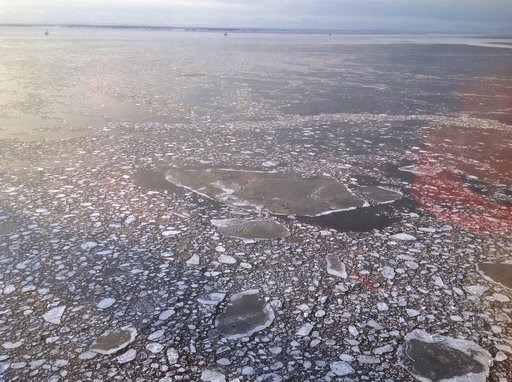Leak Raises Concerns About Aging Alaska Subsea Pipelines

ANCHORAGE, Alaska (AP) – Alaska’s picturesque Cook Inlet is home to endangered beluga whales and wild salmon – and a spider web of oil and natural gas pipelines on the sea floor, many of them placed there five decades ago.
Cook Inlet’s petroleum production is often overshadowed by Alaska’s giant North Slope oil fields, but the inlet is in the spotlight as millions of cubic feet of natural gas spew from an underwater pipeline owned by the inlet’s largest petroleum producer, Hilcorp Alaska LLC.
The federal agency that oversees pipeline safety has “strongly recommended” that Hilcorp develop a safety management system for its pipelines.
Environmental advocates are demanding immediate pipeline inspections by federal authorities, not Hilcorp, in the area with earthquakes and some of the world’s strongest tides.
“The age of the pipelines significantly increased the risk of failure, especially when coupled with the harsh offshore Cook Inlet environment,” Kristen Monsell, an attorney for the Center for Biological Diversity, wrote in a letter to the federal Pipeline and Hazardous Material Safety Administration.
Hilcorp has not said whether it will craft the safety management system but insists the age of its pipeline system does not pose a threat and would not affect maintenance and inspection requirements already enforced by state and federal regulators.
“Hilcorp is ready, willing and able to make the necessary investments to keep us working in Alaska for many years to come,” said David Wilkins, Hilcorp Alaska senior vice president, in an emailed response to questions.
The inlet lined by mountains stretches 180 miles (290 kilometers) from the Gulf of Alaska to Anchorage. Humpback whales, Steller sea lions, northern sea otters and salmon swim in its waters.
Besides earthquakes that periodically rattle Cook Inlet, tides fluctuate more than 25 feet (7.6 meters) and are so strong that they move car-size boulders along the sea floor, said Lynda Giguere, spokeswoman for the Cook Inlet Regional Citizens Advisory Council, set up after the Exxon Valdez oil spill to promote environmentally safe marine transportation.
Hilcorp entered the Alaska market in 2012 and owns 15 of the 17 Cook Inlet petroleum platforms. The gas leak is in a pipeline carrying processed natural gas from shore to four platforms, where it’s burned to provide electricity.
An analysis of gas flow indicated the pipeline probably started leaking in mid-December and initially spewed up to 310,000 cubic feet (8,780 cubic meters) of natural gas per day. Hilcorp lowered pressure in the line to reduce the flow to 85,000 to 115,000 cubic feet (2,407 to 3,257 cubic meters) per day.
Divers on Monday in 80 feet (24.4 meters) of water found a 2-inch (5-centimeter) gash on the bottom of the line where it rests on a boulder embedded in the sea floor. Repairs are underway.
On April 1, Hilcorp shut down a separate pipeline carrying crude oil from a production platform after workers felt an impact, saw bubbles surfacing from the water and spotted oil on the surface.
Based on the size of the slicks, Hilcorp estimated that less than 3 gallons (11.5 liters) of oil spilled. Hilcorp said tests showed the pipeline was not the source of the spill and an investigation is underway to find it.
Also on April 1, Hilcorp shut down a pipeline that carries natural gas from a production platform to an onshore processing facility after discovering that volumes produced did not match what was received.
Fourteen of Hilcorp’s 15 platforms were built in 1968 or earlier. The company has spent $165 million on maintenance and infrastructure in Cook Inlet and plans to spend an additional $31 million in 2017, Wilkins said.
The pipelines made of steel have special corrosion protection treatment and are covered in a cement-based product to keep them weighed down.
While environmentalists say older pipelines pose greater risks, Wilkins said the industry and even some regulators disagree.
He cited former National Transportation Safety Board Chairwoman Deborah Hersman, who said in 2013 that age is not an issue for adequately maintained and inspected pipelines.
“Steel pipelines can last indefinitely with proper maintenance, inspections and steps to prevent corrosion,” Wilkins said.
Related News
Related News

- Keystone Oil Pipeline Resumes Operations After Temporary Shutdown
- Biden Administration Buys Oil for Emergency Reserve Above Target Price
- Freeport LNG Plant Runs Near Zero Consumption for Fifth Day
- Enbridge to Invest $500 Million in Pipeline Assets, Including Expansion of 850-Mile Gray Oak Pipeline
- Mexico Seizes Air Liquide's Hydrogen Plant at Pemex Refinery
- Evacuation Technologies to Reduce Methane Releases During Pigging
- Editor’s Notebook: Nord Stream’s $20 Billion Question
- Enbridge Receives Approval to Begin Service on Louisiana Venice Gas Pipeline Project
- Mexico Seizes Air Liquide's Hydrogen Plant at Pemex Refinery
- Russian LNG Unfazed By U.S. Sanctions




Comments